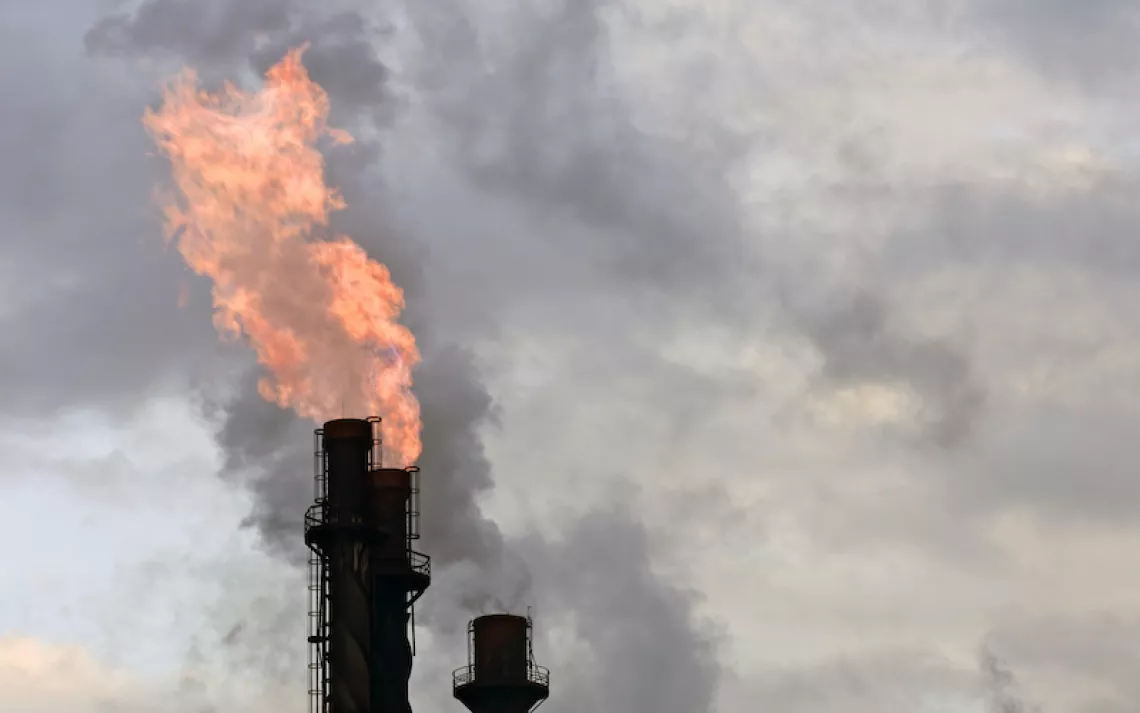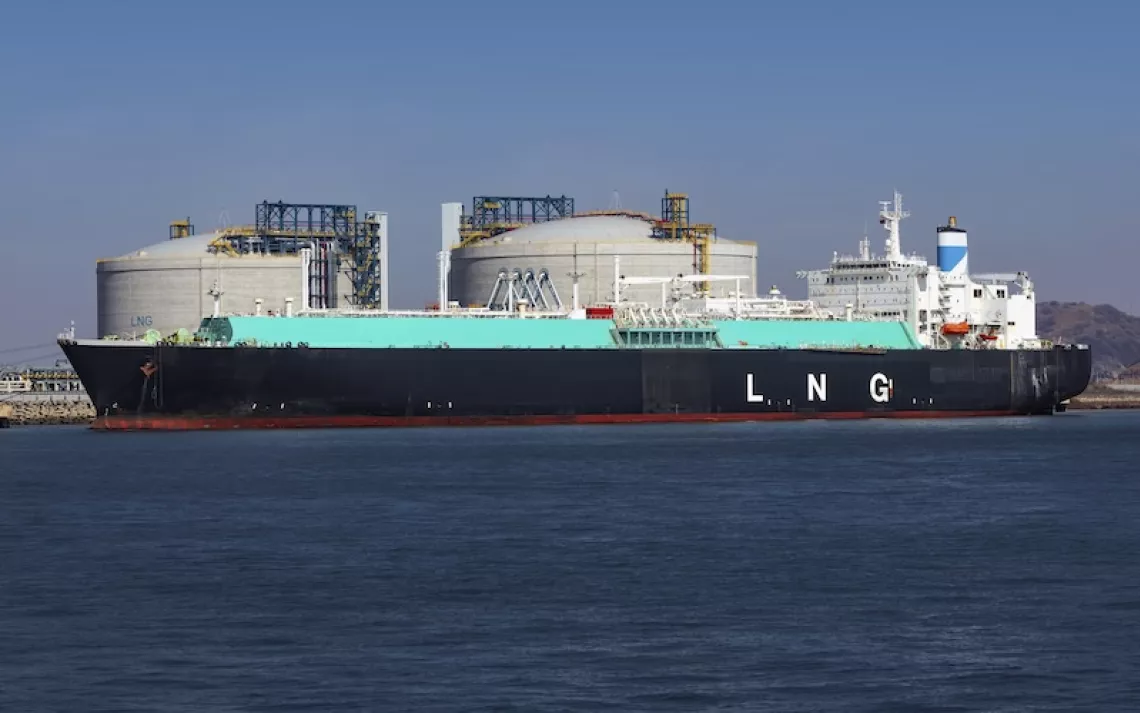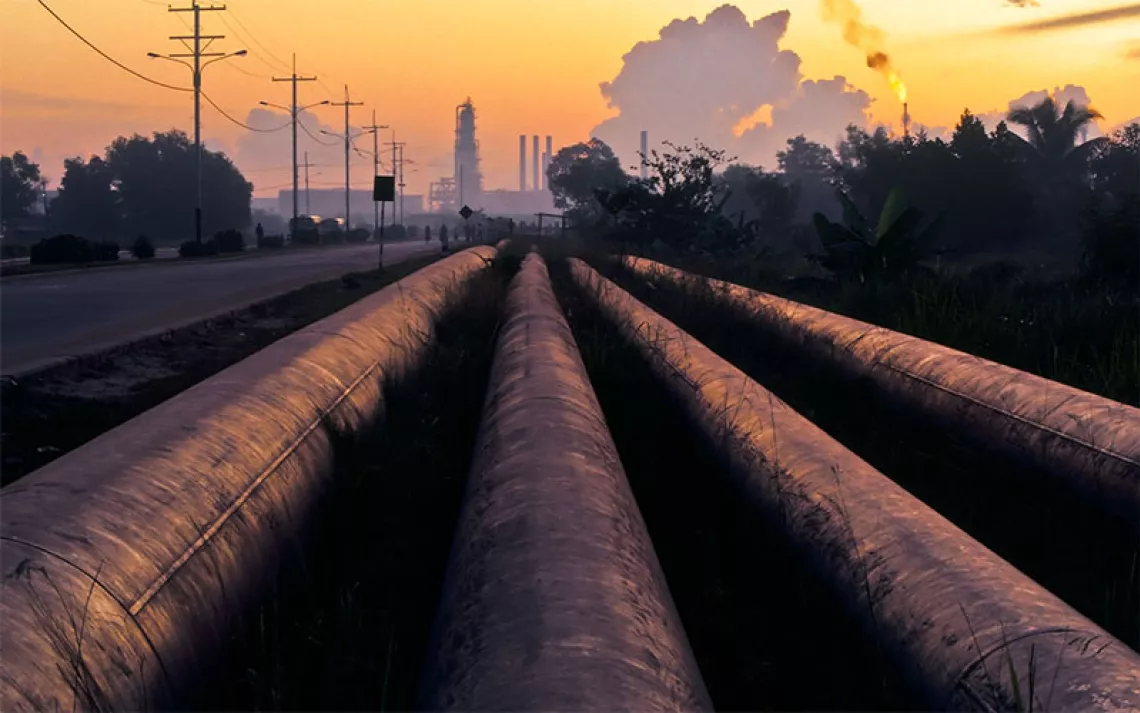The Past, Present, and Contested Future of LNG Terminals Along the Gulf Coast
Gas export terminals have hollowed out communities in Texas and Louisiana—but some residents are fighting back
“Another shared thing that has come up recently is about hurricanes and evacuations,” Cossé said. His grandmother, he noted, evacuated the same way for 60 years, “until now,” due to the traffic and LNG infrastructure blocking certain routes. “Now there’s so much more fear and anxiety around the ability to get out, because of industry and their occupation of the parish.”

Of course, it doesn’t have to be this way.

Imagine, like a film run backward, that the flare stacks go down. The liquefaction units empty.

The concrete trembles and lifts, and the landscape returns to marsh grass and egrets, saw palmetto and fiddler crabs. The shrimp come back.
Imagine the time before the terminal was built.
It might look something like Brownsville, Texas.

Shore habitat in the Laguna Atascosa Wildlife Refuge. | Photo by wildnerdpix/ Alamy
Stage I: Brownsville
Hugging the Texas-Mexico border and nestled by the white-sand South Padre Island, the city of Brownsville has, for a long time, been considered the last bit of Texas coast not given over to heavy industry.
But in 2015, a company called NextDecade set its sights on building an LNG facility there.
An $18 billion export terminal, Rio Grande LNG, might someday sprawl across a three-mile strip of land between the city center and the coast.
Still in the early stages of construction—and still intensely contested by local and national organizations that hope to stop it—the LNG facility’s storage tanks and liquefaction units could end up among some of the most vibrant coastal wetlands in the country.
Across the road from the construction site is Bahia Grande, one of the continent’s greatest wetland restoration victories.
And connected to that tidal basin is Laguna Madre, one of the largest hypersaline lagoons on Earth. Herons and ibis and ducks in great flocks wade in the shallows. If Rio Grande LNG is completed, these habitats will sit in the shadow of the largest new-build energy infrastructure project in US history.
Aerial view of wetland landscape in Laguna Atascosa National Wildlife Refuge, Texas. | Aerial Connection via Getty Images
Josette Cruz hopes it won’t ever be completed. Cruz grew up in Brazoria, south of Houston, and one of her earliest memories is the smell of a flare stack she passed as a child. She was often sick, wrestling with allergies, asthma, and psoriasis. When she moved to Texas City as an adult, she noticed that the air “smelled like nail polish remover.”
Those experiences began to make sense only around 2016, when she was working on Senator Bernie Sanders’s presidential campaign and met Josh Fox, director of the documentary Gasland. Fox referenced the big fight against LNG underway in Texas. But Cruz said, “[I] didn’t understand the term sacrifice zone, and what it really meant, until I started reflecting on my time in Texas City. That’s when I realized.”
Residents in and around Brownsville first heard about the proposed LNG project in 2014, and very shortly thereafter began to organize against it. Cruz got involved a few years later and now works with Rebekah Hinojosa, a veteran environmental organizer, and Christopher Basaldú, a member of the Carrizo/Comecrudo Tribe, the original residents of the area. Basaldú and Hinojosa are both former Sierra Club organizers. In 2020, they cofounded South Texas Environmental Justice Network, whose offices are located just a few blocks from the razor-wire-topped fence that marks the international boundary.
Basaldú and Hinojosa warn that if Rio Grande LNG is completed, their border community will face the same impacts already suffered by Cameron and Plaquemines Parishes in Louisiana. “The hospital in Brownsville already doesn’t have enough services for the population,” Hinojosa said. Basaldú worries that water will become a problem. “LNG really needs incredible amounts of water.”
Brownsville has long been vulnerable to drought; upon arriving at the airport, visitors are greeted by placards encouraging water conservation. “There’s been long-term drought, but particularly this year, farmers in Hidalgo County and Cameron County weren’t even allowed to plant some crops in certain areas because of the water shortage,” Basaldú said. Building a water-intensive, industrial project in a semiarid environment that’s facing temperature increases simply isn’t sustainable, he said.

Cormorants, great white pelicans, and terns fly, roost, and feed on an island in the Laguna Madre. | Photo by Bob Daemmrich/Alamy
According to filings from the Federal Energy Regulatory Commission, NextDecade anticipates using about 3.1 million gallons of water per month during construction; and then, during operation, up to 3.7 million gallons per month. That means every minute, the terminal will use 85 gallons of water—more than the average Brownsville resident uses over the course of a day. “They want the water, which we’ve never had, for industry. But they want us to not have the basics that we need,” Basaldú said.
Since NextDecade proposed the terminal, Hinojosa has fought the project from many angles, and her efforts have helped to delay the project again and again. She helped convince the insurance company Chubb and the banks Société Générale and Credit Suisse to cease underwriting the project. Those tactics successfully forced another company to cancel its planned LNG terminal in Brownsville. Organizing by Hinojosa and her allies slowed Rio Grande LNG to a near standstill: NextDecade originally said its facility would be operational by 2020. The company didn’t break ground until October 2023, and today it’s still in the early stages of construction.
It helped that in nearby Port Isabel, South Texas Environmental Justice Network found an ally in a local government official willing to oppose LNG. Port Isabel city manager Jared Hockema has been an outspoken opponent of Rio Grande LNG, attending protests against the plant and working closely on the litigation to halt it. He said politicians must hold the long-term welfare of their constituents as their lodestar and not sacrifice quality of life and the environment for industry promises. “If we ruin it, we can’t get it back,” Hockema said.
He argues that his opposition to LNG is an economic calculation, not just math of the heart: While construction jobs are portable, single moms with hospitality jobs can’t just move elsewhere. The city manager’s opposition to the project has already led to one small victory. The local school district denied NextDecade’s request for a tax abatement (though the county did approve a break for the developer’s property taxes).
More wins look possible. Hinojosa and allies, including the Sierra Club and the Carrizo/Comecrudo, scored a major victory in September when a DC district court pulled Rio Grande LNG’s federal permits. The court vacated the permits on the grounds that the company hadn’t sufficiently considered environmental-justice impacts. Construction is ongoing while the appeals process plays out, but the ruling gave anti-LNG organizers hope that the decision could set a precedent for halting projects that once seemed to have ironclad approval. A month after the decision on Rio Grande’s permits, the Southern Environmental Law Center filed a petition challenging the approval of CP2 in Cameron Parish.
If the Brownsville ruling is upheld and construction were to cease, the local advocates will have shut the door on what would have been 6 percent of US LNG exports. NextDecade is nervous. In a petition to the court in October, the company worried that “the project may collapse entirely.”
Even though there’s a flock of construction cranes already busy at work over a 1,000-acre spread of poured concrete, Hockema said the years of delays represent a victory in and of themselves. “That’s eight years our kids didn’t breathe dust, eight years they weren’t subjected to hazards,” he said. And Hockema remains hopeful—not necessarily because the plant’s opponents are winning but because they’re fighting. “It’s not about the odds. It’s about what’s at stake.”
Another Future

The Gulf marshlands are essential habitat for many bird species, including white ibis.
Many LNG opponents always assumed that no matter the election outcome, they would still be involved in an intense political battle. “No administration’s gonna save us,” Hinojosa said in the fall. “We’re the ones who have each other’s backs.” While Trump’s victory certainly made the future darker, Hinojosa, for one, was largely unfazed—in large part because she has spent so many years fighting LNG during both Republican and Democratic administrations. “We’ve been resisting LNG in the [Rio Grande] Valley for over 10 years,” she said the week after Trump’s ballot box victory. “Communities on the ground need support now more than ever.”
Hinojosa and her allies believe it’s the locals—the fishers, the mothers, longtime residents and immigrants alike—who are key to saving the future of this region, with all its beauty and salt. Pride of place will help fuel the fights still to come. Such pride was visible one warm October evening, as shrimpers and fishers stood waist-deep in the bath-warm waters of the Bahia Grande wetlands and worked for a catch. Pelicans winged their way low across the water as white egrets, bills tucked under wing, slept where they stood. A man held up the fine mesh of his shrimp net and shouted gleefully in Spanish to his daughter on the shore.
Behind her, across the road, towered the blinking red lights of cranes, poised to continue building the terminal in the morning. And in the other direction? In the distance, faint against the pink dusk, a dozen wind turbines spun.
There is another kind of future, just across the water. It’s hard to reach. But it isn’t too late to get there.
What You Can Do
Call on federal officials to halt dangerous gas exports: sc.org/ban-lng.
 The Magazine of The Sierra Club
The Magazine of The Sierra Club



























